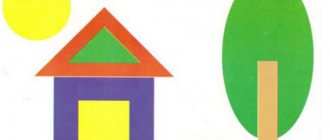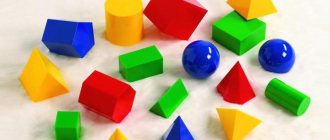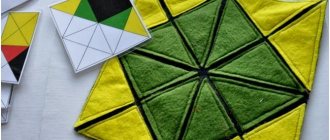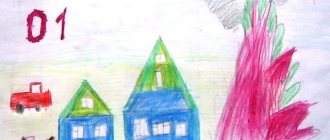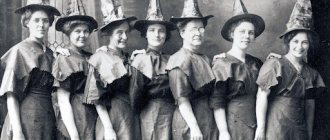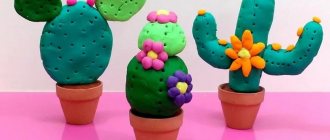Drawing from geometric shapes is a task for preschool and primary school children that allows them to develop spatial imagination, knowledge of geometric shapes and improve motor drawing skills.
For your convenience, we have made coloring pages of geometric shapes that you can print and color (for preschoolers). After each coloring, an example of a drawing on the same topic is presented. Children complete the drawing independently using a ruler and color it with paints or pencils (for schoolchildren). Coloring pages and drawings are made on the following topics:
- "Air Transport"
- "Toys"
- Animals from geometric shapes “Cat and Mouse”
- "Transport"
- "House in the village"
- "Sea and Ship"
- "Railway"
- "Forest New Year's Tale"
- "Summer Glade"
- "Space flight"
Drawings of geometric shapes for children - lesson plan
- Start the lesson by finding out what geometric shapes the child remembers. He must confidently name and see circle (semicircle), oval, square, triangle and polygon . Older children will be able to see the broken line in the drawings.
- Find the geometric shapes in the picture. The more geometric shapes a child finds, the better. You can count them.
- Fill the coloring book with color or draw the selected composition. It is very good if the child goes further and draws his own elements of the picture.
At what age can you start teaching geometric shapes to your child?
According to scientists, a child should be taught from birth, and it is carried out in several stages:
- After birth, the baby remembers almost nothing, but learns to look at the world in all its aspects. At this time, it is recommended to talk to the baby, pronouncing each figure, read short children's poems, and sing songs.
- When the baby turns 6 months old, he will try to learn more about the world. To do this, he will touch and bite objects. It is important to choose the right toys. A set of soft squares with flowers, butterflies, and birds painted on them will do.
- The next stage begins when the baby learns to speak. It is necessary to pronounce all the names of the shapes, starting with the simplest ones (circle, triangle, square). Then comes the turn of the trapezoid, rectangle and others. A toy pyramid, plastic cubes used to build a tower, and drawing will help at this stage.
Studying geometric shapes with a child can begin from a very early age.
Thus, learning can be done from the birth of a child, using different techniques.
Composition of geometric shapes drawing “Air transport”
Drawing of geometric shapes 1st grade - air transport. An airplane, a hot air balloon and a helicopter will pique the interest of boys. You can tell interesting facts about the structure of transport, its speed, the history of its creation and its role today.
Coloring page "Air transport made of geometric shapes"
Drawing “Air transport from geometric shapes”
Study of geometric shapes: names, shape, color, size
As the child ages, he should recognize more and more shapes and colors.
By age 2 you need to know:
- triangle;
- square;
- circle.
At the same age you need to know the basic colors:
- blue;
- red;
- yellow;
- green;
- white.
By the age of 2, a child should know basic geometric shapes and colors.
Some children at 2 years old know several more colors:
- orange;
- violet;
- black;
- pink.
By the age of 6, the child learns about more complex, combined colors and shades, and becomes familiar with composite (consisting of basic) figures.
Children learn through games; they come in varying complexity, so it is recommended to give them to your child in the following sequence:
- Circles, triangles, squares of different sizes and colors drawn on cardboard. Call the images by their proper names, saying them out loud.
- Draw only the outlines of the figures on the cardboard, and all the outlines should be of different colors, so that the child traces them with the corresponding colors, paints them and pronounces the names out loud. From the age of 2 years, you should start comparing sizes.
A sorter with geometric shapes helps children learn them
- Cut out the shapes and place them in prominent places in the house so that the baby can look for the pictures. Each time the child finds an image, he must name the following characteristics: shape, color and size.
- Game sets designed to study the above. For example, a pyramid, mushrooms of different colors and sizes on a stand, mosaic and others. Such games will entertain the child and attract his attention.
- Search for geometric shapes in the surrounding world. For example, a table is a rectangle, a box is a square, and a ball is a circle. It is recommended to consider more complex shapes: the glass is a cylinder, and the festive cap is a pyramid.
Many techniques have been developed to study shapes and colors. They are designed for children of different ages, and also take into account their favorite activities.
Drawings from geometric shapes (selection from the Internet)
Coloring page of geometric shapes “Cockerel”
Drawing of geometric shapes “Cockerel”
Coloring book of geometric shapes “House”
Drawing of geometric shapes “House”
Coloring page of geometric shapes "Robot Soldier"
Drawing of geometric shapes “Robot Soldier”
Coloring page of geometric shapes "Flower"
Drawing of geometric shapes “Flower”
Bee made of geometric shapes
Coloring page of geometric shapes “Sunny Street”
Introduce your child to geometric shapes: circle, square (rectangle), triangle. Show him these figures in drawings and cut out of paper. Teach to find their forms in the environment. Use the didactic game “Miracle Bag”: a fabric bag contains small objects of different geometric shapes, made of wood or plastic. Together with your child, cut out a set of these shapes of different sizes and colors from colored paper. Train your child to select only triangles, or only circles, or squares from a variety of cut-out shapes. Teach your child to draw these figures, first on a sheet of paper, then using a stencil, and later using a ruler and compass.
Miracle bag
You can use the “Miracle Bag” set for the game or just a bag made of opaque fabric, and several small objects of different shapes specially selected for the game: square - boxes, chewing gum, cube, ball, ball, ball. Ask your child to take out all the round objects first, then all the square ones. Check that the task is completed correctly.
Ride through the gate
Introduce your child to the geometric shapes cube and ball. Play the following board game: invite your child to roll a cube and a ball through the gate (we denote it on the table with two cubes). Let the child try to complete this task. Then analyze his observations with him: “The ball is round in shape, so it can easily roll or stand still, but a cube cannot roll, the corners interfere with it. It can stand still or be turned from side to side. His sides are all the same.”
Patterns of geometric shapes
From colored paper, cut out several equilateral triangles (12 or more). Who will put together the most figures? What geometric shapes can be made from them? Square, rectangle, triangle. You can assemble a star from 12 triangles: first, assemble the center of the star - a hexagon. Then from the remaining six triangles you make rays towards it.
Triangle
Show your child a geometric figure - a triangle. Explain why it is called that - because it has three corners. Let the child name the triangular objects in the environment. Play with the “miracle bag”, let the child take out all the triangular-shaped objects from it.
Houses
Give your child a set of paper triangles - two squares, one larger, one smaller cut diagonally, and a figurine of a paper animal (hedgehog, bunny). Invite your child to assemble a house for a paper animal from triangles. All available triangles must be used in the construction of the house. There may be several options. If your child finds it difficult to find several options, help him.
Christmas trees
Give your child a set of three triangles with equal sides. Invite your child to make Christmas tree shapes from these triangles. There can be two versions of the herringbone: the first - three triangles are located one above the other, touching the top of the lower one with their base, the second - the lower large triangle is made up of two small ones, with adjacent sides, and the upper triangle touches the base of the top of the lower one. Most likely, the child will collect the first option. Offer him the second option. Let him compare two Christmas trees and say which one is taller and which one is lower.
Fish
Give your child a set of four identical paper triangles; make the triangles from two identical squares cut in half. Invite him to collect different fish from them using any means (you can’t put triangles on top of each other). You will get 4 variants of fish. The most interesting fish can be turned into an applique.
Square
Show your child the square, tell him what this figure is called and what is its peculiarity: all sides of the square are the same. How can I check this? Let the child offer his own options. Then show him how else you can do this: alternately fold the square along two diagonals. If the sides coincide when superimposed one on one, then they are the same, and this figure is a square. Invite your child to make a square using sticks. Do not specify the number of sticks. Perhaps he uses one stick per side, or perhaps several. Depending on this, invite him to fold a larger or smaller square. Let the child name square-shaped objects in the environment.
A child or group of children is offered a set of five squares and five triangles of different sizes and colors, as well as paper figures of five gnomes in multi-colored caps. An adult tells the children that a strong wind tore the roofs off the gnomes' houses and asks them to fix them - to assemble houses from rectangles and triangles, choosing a triangle - a roof for each square house. Let the children explain by what signs they will determine which roof belongs to which house (by size, by color). When the houses are assembled, you need to take each gnome to his house, focusing on the color of the cap.
Rectangle
Show your child a paper rectangle. Name it. Compare the overlay method with a square half the size. Analyze how a rectangle differs from a square? A square has all equal sides, and a rectangle has equal top and bottom, left and right sides (opposite). Show your child paper rectangles of different shapes, check the equality of their opposite sides by folding the rectangles in half. Have your child name rectangular objects.
Select what you need
On a tray in front of the child are geometric shapes of different sizes and colors. You give the child various tasks: name all the figures that lie in front of him, lay out all the triangles from the tray onto the table; all squares; all rectangles; all the figures are of a certain color, the figures are of a certain shape and a certain color, the figure is large or small. Count them.
Collect the figure
Offer your child a large set of different geometric shapes: squares, isosceles triangles, rectangles of different sizes. Invite him to assemble geometric shapes of different sizes from any shapes he knows. He can use any shapes and any methods of their arrangement. The more options, the better.
How many points?
A large sheet of whatman paper is drawn with lines into different geometric shapes: rectangles, squares, triangles. A child and an adult alternately throw a dice onto a piece of paper and see which figure it lands on. Agree in advance how many points are given for a piece of a certain shape, for example: triangle - 1 point, square - 2 points, rectangle - 3 points, as well as how many throws can be made. That one will win. Who will get more points in a certain number of moves. One child can play. Then the task will be different: from a set of paper figures, find a figure of the same shape on which the cube fell.
Geometric relay
Game for a group of children. Children are divided into two teams and stand behind each other at one end of the room. There is a chair next to each team. On the opposite side of the room, there are square and round objects mixed together on the table. At the signal, the players of each team run to the table, take the object: the players of one team are round, and the other is square, carry it to the rest of the team members and place it on a chair. Then other team players run for the items. This continues until each participant brings an item. The team that finishes first and without mistakes wins.
Labyrinths
You can draw the mazes yourself with your child or use samples. Check the statement that you can get out of any maze if you turn only to the left.
Tangram
Tangram is an oriental puzzle, which is a square with a side of 8 cm, cut into seven parts, from which you can create a large number of different figures and patterns.
Games with counting sticks
Games with counting sticks also develop ideas about geometric shapes.
Game 1 . Make a square and a triangle from counting sticks, the sides of which consist of 1 stick.
Game 2 . Make a rectangle out of counting sticks, with sides 2 sticks and 3 sticks.
Game 3 . Make two squares from 10 sticks - large and small; You will place the small one inside the large one, using the sides of the large square when constructing.
Game 4 . Make a square and two identical triangles from five sticks.
Teach your child to use measuring strips of paper to measure objects. Play the following games with him:
Game 1. Four children are playing. They are sitting at the table. Game 4 each has a picture with two Christmas trees, one tree is higher, the other is lower, and two strips of paper the same length as the trees. Children are asked what needs to be done to find out which tree is taller. Assignment: measure the Christmas trees and draw a mushroom next to the one above. Possible options: measure the Christmas trees with different strips, which then compare with each other; measure with one strip. Once each child has measured their Christmas tree and determined which is taller, ask the children to determine which person at the table has the tallest tree? How to determine this? If the children find it difficult to answer, prompt them: they need to take the measurement of their tall Christmas tree and compare it with the measurements of the tallest Christmas trees of other children.
Game 2 . Four children are playing. In front of each is a picture of a ladder, scissors and a measuring strip. An adult puts a picture of a street lamp on the table and says: “This is a street lamp. It's broken, it needs to be fixed. For this you need a ladder. What kind of ladder can you use to repair a lantern?” Children should come to the conclusion that they need to use a measuring strip: use it to measure the height of the pillar, and then the length of each ladder and choose the one they need.
Cut out a set of strips of different lengths and widths from colored paper and regularly practice comparing them using the overlay method. When comparing, use the words: longer, wider, narrower, shorter. Compare objects in your environment using adjectives: narrow, wide, long, short, high, low, as well as comparisons: higher, lower, wider, narrower.
Game 1. Invite the child to list objects of a certain size: a) tall; b) low; c) wide; d) narrow.
Game 2. Let the child list objects of a certain shape: a) triangular; b) rectangular; c) round.
Game 3 . Invite your child to list things made of a certain material: a) glass; b) wooden; c) metal, etc.
Game 4. Toss the ball with the child, saying words of opposite meaning, denoting quantities: high-low, short-long, wide-narrow, thick-thin, etc.
Game 5 . Hide two pairs of toys (dolls, bears) in the apartment - toys in one pair are the same height, and in the other - different. Let the child find them and explain how they differ in height in pairs and among themselves.
Game 6. While walking, draw wide and narrow paths on the ground with a stick. Invite your child to jump over them. Which tracks were easier to jump over? Why? It's easier through narrow ones, since they are narrower.
Game 7 . During a walk, invite your child to measure his height with the children in the yard, standing back to back. Discuss who is taller, who is shorter, who is taller than everyone else. Reassure the one who turned out to be the lowest by telling him that he will still grow.
Game 8 . Place pots of different sizes in the kitchen and ask your child to choose the right lids for them. Which ones didn't fit, why? (Different sizes, larger, smaller). Which ones suited you, why? (The same). Compare the lids and saucepans with each other.
Game 9. You throw the ball with the child, naming the object and the sign of the object for each throw. The child, having caught the ball, must answer you with a phrase that has the opposite meaning. Objects can be very different, the main thing is that their characteristics are directly opposite to each other. For example: the tap is high - the hut is low, the knee socks are long - the socks are short, the path is narrow - the road is wide.
Game 10. Invite your child to measure the thickness of tree trunks while walking in the park. Thick trunks cannot be grasped with your hands, but thin ones can.
Game 11. Select objects of different sizes: two ribbons of different lengths, two bottles (with a narrow and a wide neck), two cans - high and low, two books - thick and thin, two balls - small and large. The child must look at all the objects, and when he turns away, you remove one of them. The child, turning around, must guess which object has disappeared and characterize its signs. Repeat the game several times.
Game 12 . A group of children is playing. Children stand in a circle, and an adult with a ball stands in the center of the circle and says: “Pencil, which is longer?” The child must name in response the object that is longer and throw the ball back. The ball can be thrown until the comparisons run out. You can ask what is shorter, for example: “The road is long, what is shorter?”
Game 13 . This game can be played outside. A line is drawn on the ground where you need to throw pebbles (in winter these can be snowballs). You can't go beyond the line. You can only throw pebbles when given a signal. The one who throws the farthest wins. Ask the question, how to compare, who threw further? How to measure? You can measure by steps, feet, etc.
Game 14. A pair of children sitting at a table is playing. Each person gets the same pyramid. Then the children remove the pyramid rings from the rod and mix them. Ask the children to sort the rings in order from smallest to largest. Then mix the rings again and choose identical pairs. Paired rings are found by overlapping each other.
Game 15. To play you will need several sets of sticks. Each set should contain 15-20 sticks of four to five sizes, for example 3, 4, 5, 6, 7 cm long.
It is advisable that the sets be of different colors. Both sets are mixed and laid out on the table in front of the child. His task is to sort the sticks by size and put them in separate piles. The game becomes more complicated if the sticks differ from each other in two ways: for example, in length and thickness.
Figures. Flashcards.
Activities with cards will help you introduce your child to the world around him, develop speech skills, teach him to compare, classify, and generalize.
From 6 months: Show cards quickly, clearly naming the drawn object. Leave the kit for a few days, then replace it with a new one. After a while, repeat the show. From 3 years:
• Review the cards with your child. Explain to your child that there are flat and three-dimensional geometric shapes. Invite him to divide the cards into two groups - with flat and three-dimensional figures. Instead, with your child, find the similarities and differences between these groups.
•In one lesson, study one figure in detail with your child:
- tell your child about this geometric figure, ask him questions;
- when explaining, use ready-made images of figures; Draw them instead with your child on a piece of paper; Find three-dimensional geometric bodies among household items with your child.
• Ask your child to choose flat geometric shapes for volumetric geometric bodies (ball - circle, square - cube, etc.)
•Help your child “create” three-dimensional geometric shapes. Try to obtain “bodies of revolution” by rotating flat geometric shapes around their axis.
•Describe in detail any figure drawn in the pictures without naming it. Invite your child to guess what we are talking about and choose the appropriate card. Then switch places with the child: he describes - you guess.
•Ask your child to group the cards according to different characteristics, to find what all the figures have in common and what is different.
• If the child is already learning to read, cut off the names, mix them up and offer to match the names to the pictures.
• Having several sets, you can play logic games:
— classification (sort cards by topic, select a general name);
- fourth extra (out of four cards: three on one topic and one on another, the child must choose the extra one and explain his choice).
Presentation “Game “Find an object that looks like a circle”
If the child wants to repeat his success, then on the last slide you also need to click on the circle in the upper left corner of the slide and the game will start over .
Attached files:
Didactic game “Find a Pair” State budgetary preschool educational institution Kindergarten No. 52, Primorsky district of St. Petersburg Didactic game.
Didactic game “Entertaining circle” for children 3–4 years old State budgetary preschool educational institution kindergarten No. 52 Primorsky district of St. Petersburg Didactic game. Didactic game-activity “Guess the object” (junior group) Didactic game-activity “Guess the object” junior group (children 3–4 years old) Purpose of the game: describe objects, highlighting the characteristics: material, basic.
Game with TRIZ elements "Magic Circle" Game with TRIZ elements "Magic Circle". Goal: to form in children a generalized picture of the world, to develop the ability to describe an object through signs.
Game “Find the Treasure” Objectives: 1. To develop in children the ability to navigate the area using a drawing (map). 2. Form friendly and well-wishing relationships.
Presentation “The game “Find the odd one out” for the development of thinking and speech in preschoolers.” Thinking is the process of analyzing and systematizing new information about the world around us, obtained through the senses. Man is endowed.
Presentation for the didactic game in mathematics “Find in the picture and count” for children 6–7 years old Presentation for the didactic game in mathematics “Find in the picture and count” for children 6–7 years old. The purpose of the game is to consolidate children's knowledge.
Source
How to make Doman cards yourself:
Print the cards on thick paper or cardboard, 2, 4 or 6 pieces per sheet. To conduct classes using the Doman method, the cards are ready, you can show them to your child and say the name of the picture.
Good luck and new discoveries to your baby!
Educational video for children (toddlers and preschoolers) made according to the Doman method “Prodigy from the cradle” - educational cards, educational pictures on various topics from part 1, part 2 of the Doman method, which can be watched for free here or on our Channel Early Childhood Development on YouTube
Source

